| Ansel Watrous (Jr.) was
born on Jan. 10, 1839 in Broome Co.,
New York, the youngest of at least
nine children of Maj. Ansel Watrous,
Sr. (1792-1866) and his wife Demise
Luce Watrous (1794-1866)
Young Ansel Watrous
first appears in NY on the 1850
Census in the town of Conklin,
Broome Co, NY with his parents Ansel
(b. CT) and Demise Watrous (b. NY)
and his two older brothers, George
A. (b. PA) and Charles O. (b. NY).
Ansel (Jr.) was 11 years old, which
calculates to an 1838-39 birth year.
1850
Census, town of Conklin, Broome Co.,
NY
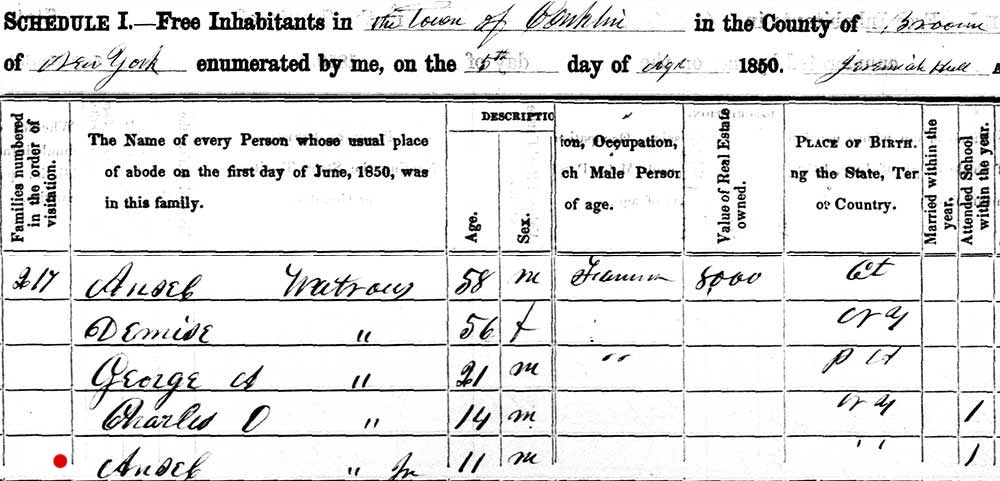
Ansel Jr. and his
brother Charles were attending
school. Their brother George
and father Ansel Watrous were
farmers.
There ages are indicative of Ansel
Sr. & Demise having several older
children no longer living with them.
1855 NY State Census, Broome Co,
Town of Conklin
There was an 1855 State Census taken
in NY. The Watrous family was
living in the same location--the
town of Conklin.
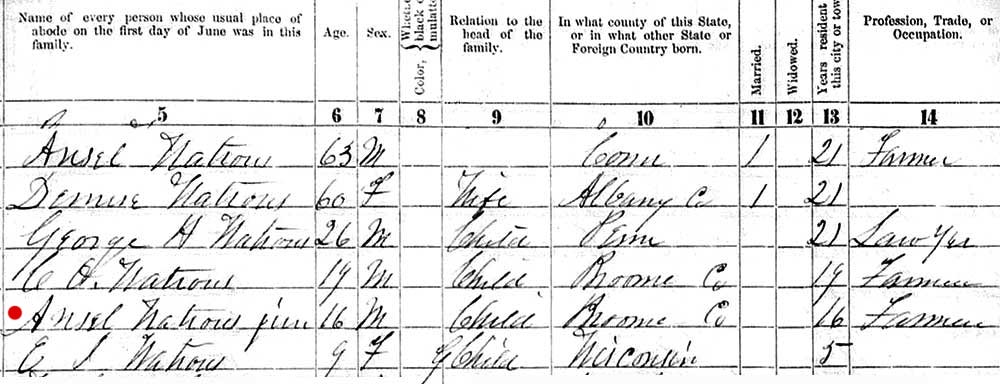
This census listed
in column 10 what county a person
was born in if they were born in the
state of NY, otherwise what state or
country they were born in.
Demise was born in Albany Co., and
sons Charles and Ansel Jr. born in
Broome Co. Column 13 asked how
may years each person was resident
in the present location. Ansel
(Sr.) and wife Demise had moved
there 21 years prior, so around
1834. Their son George was was 26
but there 21 years and born in PA.
So they likely came to Broome Co.
from Pennsylvania when George was
around 5 years old. Listed
last is a 9 year old female
grandchild, E. J. Watrous, who was
born in Wisconsin. She was in
Conklin for 5 years. This
indicates that Ansel Sr. & Demise
probably had an older son who had moved to
Wisconsin before their 1850 Census,
and for some reason his daughter was
living with the Watrous family at
this time. She must have
arrived in 1850 after that census
was taken.
According to Steven B. Watrous, a
rather diligent researcher and
member of the Watrous family who has done
excellent research with source
citations to numerous official
records, the family of our Ansel
Watrous Jr. was quite large. As
seen below, his father, Maj. Ansel Watrous (Sr.)
was one of 13 children of Benjamin
Watrous and Lucy Spencer.
There were nine children of Maj.
Ansel Watrous and Demis Luce, with
our Ansel Jr. being the youngest.
Those children marked with green
dots had already moved out by the
time of the Watrous 1850 census.
With the first Lucy (Marie) having
died in 1832, Ansel (Sr.) and
Demis used the same name for their
daughter born in 1833.
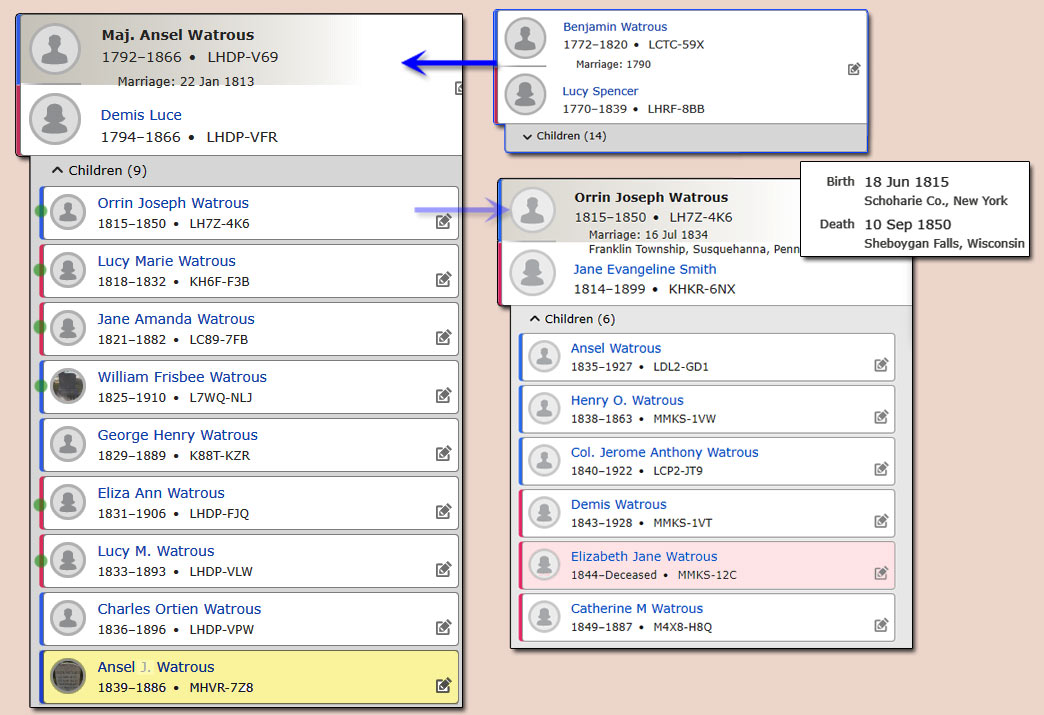
As
for "E. J. Watrous," the
granddaughter on the Ansel Sr/Demis
1855 census in Conklin, it is now
apparent that she was Elizabeth Jane
Watrous, a daughter of their oldest
child, Orrin Joseph, who had 6
children and had gone to Wisconsin..
It appears that Elizabeth was sent
to Conklin to live with her
grandparents when her father died
in Wisconsin.
There
are other descendants of the rest of
the Ansel Sr & Demis Luce children,
in addition to Orrin's, not shown
here.
You can see more of this family at
Familysearch.org
ANSEL WATROUS, JR. MARRIES IN MISSOURI
By
September of 1859, Ansel Jr. had
gone to Oregon City in Holt County,
Missouri. There he met Melinda
Burnett and married her on Sep. 22,
1859. She was a daughter of
Virginia native Roland Burnett and
his wife Nancy Neil, a native of
Tennessee.
The Burnett family was living in
Oregon City, Mo. and are
found on the
1850 Census with 10 children
where Roland was listed as a farmer
and Melinda is listed on the next page
as "Melvina" Burnett, and on
the
1860 Census in Oregon City, Mo.
According to the
family tree of Roland Burnett,
Melinda was
the 7th of 11 children.
1860 Census, Oregon City, Holt Co.,
Missouri
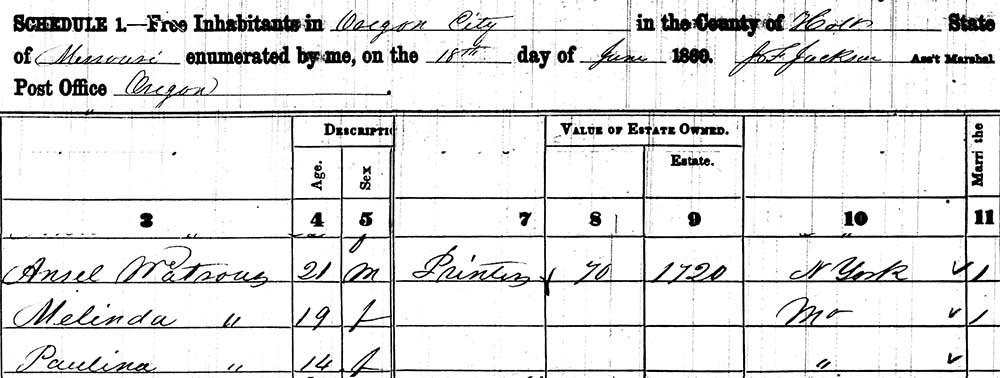
Ansel was 21 and working as a
printer. The value of his
property and estate was
significantly lower than others on
the page.
Notice Column 11 indicates he and
Melinda had married within the past
year. Melinda was 19 and born
in Missouri.
It's not yet known who Paulina
Watrous was. Her birthplace of Missouri, if
not an error, would normally
indicate she was a member of
Melinda's family and probably a
Burnett. No research has been
done yet as to why Ansel Jr. went to
Missouri or if other Watrous family
members lived there.
ANSEL WATROUS
JR. CIVIL WAR SERVICE
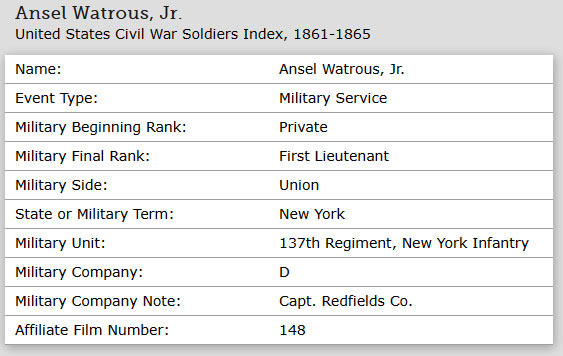
Ansel
Watrous Jr.
served in the Union Army during the
Civil war, initially as a Private
and ultimately as a First Lieutenant
in the 137th Regiment of the New
York Infantry, Co. D under Capt.
Redfields.
This
would indicate that by the time of
enlistment, he and his family had
gone back to New York.
Before leaving Missouri, Ansel &
Melinda's first child was born,
Harriet (Hattie) Watrous, on Aug.
18, 1860.
1865 Census, State of NY, Town of
Conklin, Broome Co.
Ansel Jr. and his family back on the Watrous Family
farm.
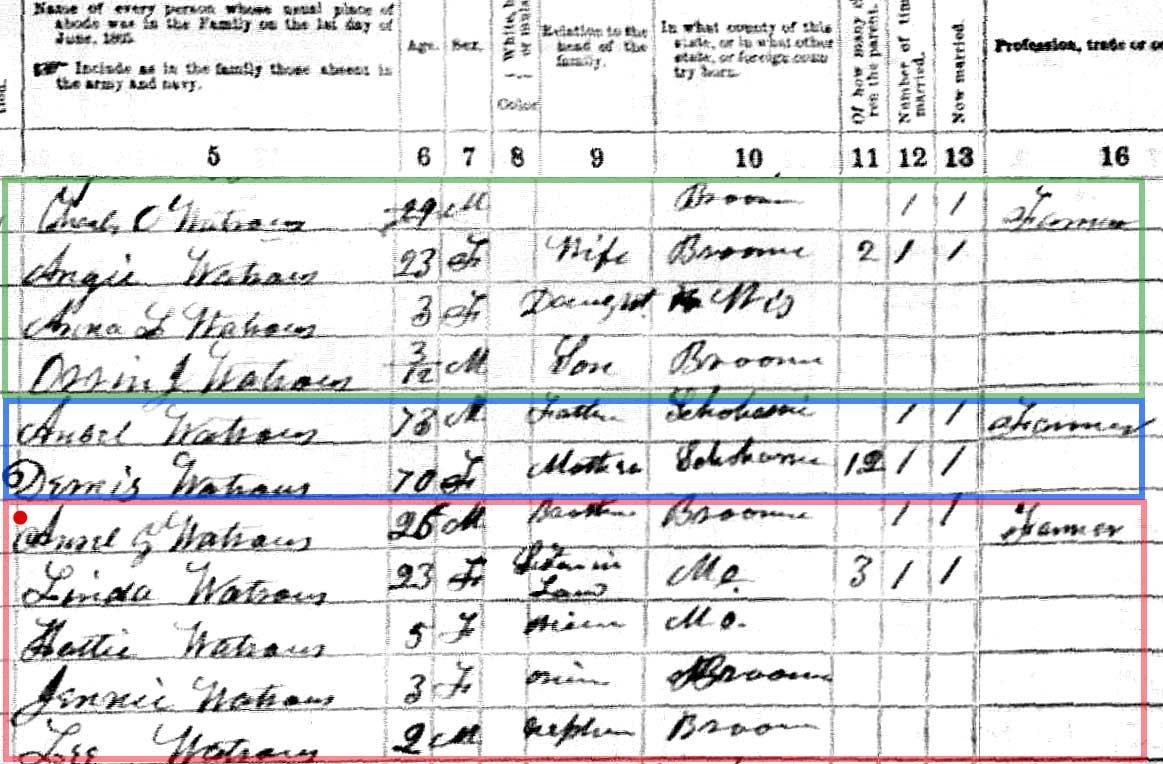
On this census, Ansel
Jr.'s brother,
Charles O. Watrous is the head of
the household, so all relationships
are with respect to him.
-
Outlined in green
is Charles, his wife Angie, and
two young children--Anna L. is 3
and born in Wisconsin. their son
Orrin is 3 mos. On the
1875 State Census of NY, Broome
Co, Binghamton, Anna L. appears
as "Laurie" age 13, born in
Milwaukee, while Orrin and four
more of Charles & Angeline's
children were born in Broome Co,
NY.
-
Outlined in blue
are Ansel (Sr.) and Demis,
parents of Charles and Ansel Jr.
-
Outlined in red
is Ansel (Jr.) and what looks to
be a middle initial "G."
This is the only record of him
showing a middle initial and
since his father never appears
with one, this may have been an
error, or he wasn't a Jr.
-
Ansel (Jr.)
& Linda had two more children
after Hattie, upon arriving back in NY.
Jennie (Eugenia) b. 1861 & Lee
(Lee Roland) b.1863, with both showing born in
Broome County. His wife
Linda (Melinda) and daughter
Hattie (Harriett) show born in
Missouri.
The numbers in
columns 11, 12 & 13 indicate how
many children they had, number of
times each person had married, and
if they were now married.
THE WATROUS FAMILY IN TAMPA
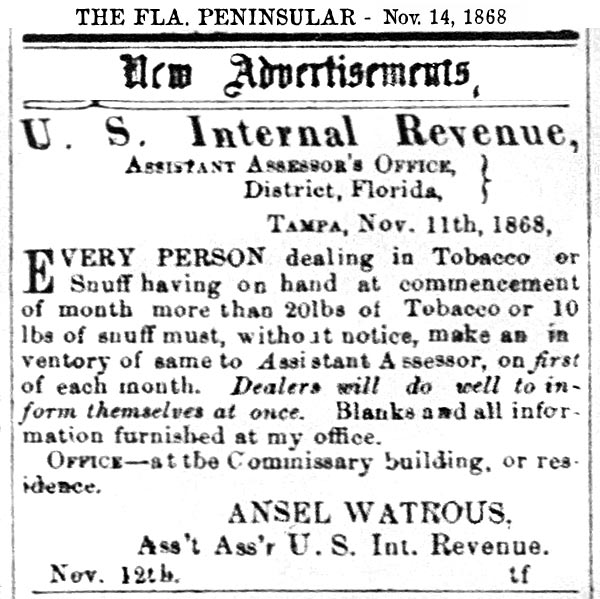
Ansel
Watrous, Jr. was the Assistant
Assessor in Tampa for the Florida
district of the U.S. Internal
Revenue office.
This
notice published in the Florida Peninsular,
is evidence that Ansel arrived no later than
Nov. 1868. It announced that tobacco
dealers with more than 20 lbs of
tobacco or 10 lbs of snuff at the
start of each month must submit an
inventory of it to the Assistant
Assessor of the U.S. Internal
Revenue office. The notice was
repeated on Dec. 12, 1868.
|
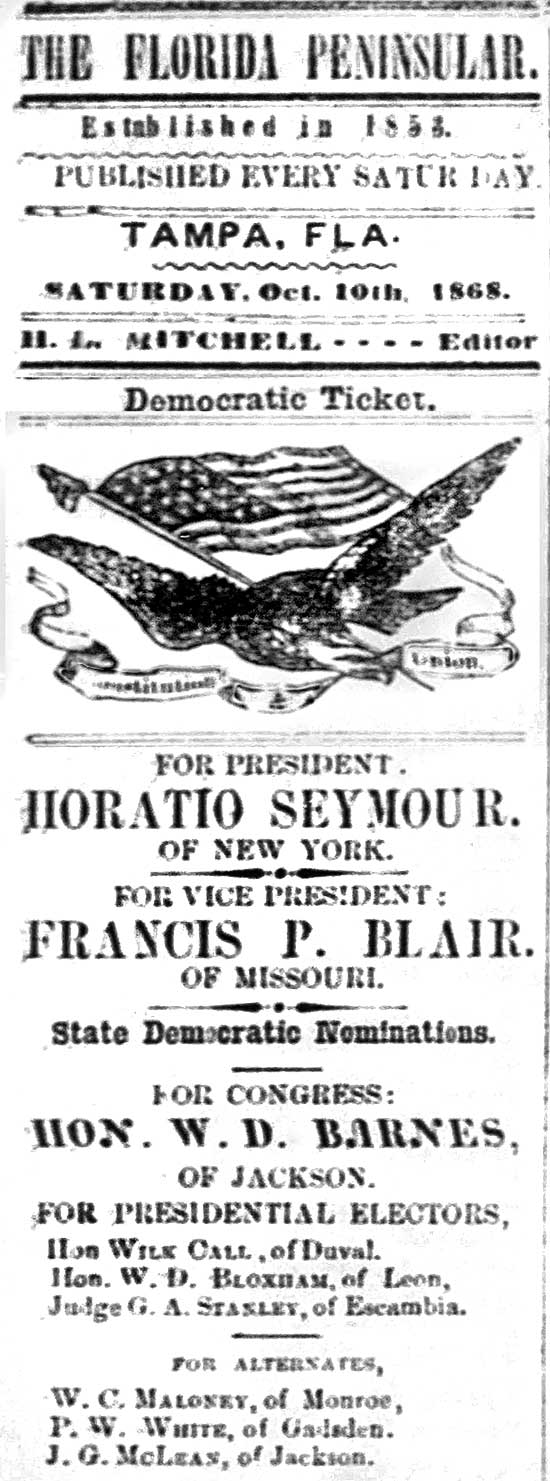 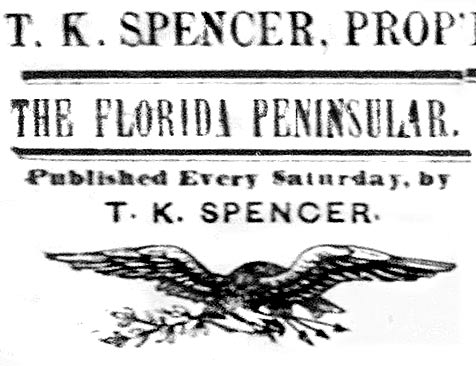 ANSEL
WATROUS IN THE PENINSULAR'S
CROSSHAIRS ANSEL
WATROUS IN THE PENINSULAR'S
CROSSHAIRS
The Peninsular was by no means
an impartial newspaper.
Like most all of Tampa and the
South, it was a PR marketing
branch of the Democrat party of
the Confederacy. During
the years of Reconstruction, it
complained incessantly about the
"injustices" Democrats suffered
at the hands of Republican
"Radicals" enforcing the
policies of the Freedmen's
Bureau. To the Peninsular,
they were all Carpetbaggers and
Scalawags. In these times,
the Democrats considered
themselves to be the
conservatives, and the
Republicans were the radicals,
or "Rads" because they were
turning upside down the Southern
way of life. The paper
frequently spewed
ridicule, criticism and sarcasm
for anything Republican, and
took every opportunity it could
to point out hypocrisy in any
Republican situation. Just
about every issue contained a
racist stereotype joke in the
guise of an article. Any
quote of a
"negro" speaking would be
printed phonetically to
exaggerate and portray a total
lack of education.
When factions arose within the
Republican party against
Republican Reconstruction
Governor Harrison Reed, it was
fuel for the Democrat fire.
HARRISON REED
Florida’s ninth governor was
born in Lowell, Massachusetts,
on August 26, 1813. In 1836 his
family moved to Wisconsin, and
Reed found work as an editor at
the Milwaukee Sentinel, the
Neenah-Menasha Conservator, and
the Madison Wisconsin State
Journal. He is credited with
founding the town of Neenah on
the Fox River.
-
After moving to
Washington, D.C., in
1861, Reed was employed
at the Treasury
Department, a position
he held until 1863. He
then was appointed by
President Abraham
Lincoln to serve as
Florida’s tax
commissioner,
negotiating about
Confederate property
that had been seized.
Two years later, he was
appointed by President
Andrew Johnson to serve
as Florida’s mail agent.
During the Reconstruction era,
in 1868, Florida enacted a new
constitution, which extended the
franchise to freedmen. Most
freed slaves joined the
Republican Party, which had
emancipated them. Reed was
elected governor under the new
constitution and assumed office
on June 8, 1868, but the results
were disputed by the Democrats.
It was not until July 4, 1868
that the federal commander of
military forces in Florida for
Reconstruction recognized the
constitution and the election as
valid. Florida was readmitted to
the Union at that time.
During his tenure, Reed had the
challenge of trying to reinstate
the state’s civil government and
re-stabilize the shattered
financial and taxation system.
He was successful in making
improvements in these areas.
JON C. GIBBS
Appointed in 1868, Jonathan
Clarkson Gibbs was the first
African-American to serve as
secretary of state in Florida’s
cabinet. Reed also
commissioned Gibbs as a
lieutenant colonel in the
Florida State Militia.
Reed faced strong opposition
during his term from Democrats
and from a faction of
Republicans who made two
attempts to impeach him.
In
the first effort, the state
senate voted for his impeachment
in Nov. 1868, and William
Henry Gleason, his lieutenant
governor from 1868 to 1870,
proclaimed himself as Governor.
The Senate had adjourned on
November 7, 1868 without
deciding whether or not to
impeach Reed. Reed's
supporters, including the
state's Adjutant General and the
county Sheriff, denied Gleason
access to the Capitol, so he set
up in a hotel and signed
documents as Governor. On
November 24, 1868, the Florida
Supreme Court held that the
Senate had lacked a quorum at
their vote and could not have
impeached Reed. Gleason was
forced out, and the political
struggle ended with Gleason's
removal on December 14, 1868.
During the Senate's second
attempt to impeach Reed,
Lieutenant Governor Samuel T.
Day claimed to be Acting
Governor from February 10 to May
4, 1872, while the senate was
conducting hearings and voting.
While his impeachment was
pending, Reed had felt he was
disqualified from holding
office, and left the capital.
The Legislature
adjourned without bringing him
to trial, which he construed as
equivalent to acquittal. While
Day was in Jacksonville for a
party caucus, Reed returned to
Tallahassee, declared himself
Governor, and appointed a new
Attorney General. Reed's
proclamation was approved by the
Secretary of State and upheld by
the State Supreme Court.
After leaving office, Reed
served as editor of the
Jacksonville Semi-Tropical
Monthly Magazine from 1875 to
1878, and he was the
Jacksonville postmaster from
1889 to 1893. Governor Harrison
Reed died on May 25, 1899, in
Jacksonville.
THE PENINSULAR PRINTS
MISINFORMATION* AND THEN
APOLOGIZES**
Apparently, H. L. Mitchell
didn't verify the report he
received on what transpired at a
Republican meeting concerning
Ansel Watrous and printed a
cynical article revealing the
motives (as he imagined) behind
what went on. That Ansel
Watrous had been nominated as
the Republican candidate for
county judge (among other
claims) in the interest of
impeaching Lt. Gov Wm H. Gleason
who had declared himself the
governor by this time. The
Peninsular favored anyone over
Reed, and so they deemed Watrous
as a threat to impeach Gleason.
A correction was printed when Mr.
A. "Wartrous" contacted
them to set them straight.
Mitchell avoids words like
error, wrong, or mistake, citing
only the "injustice" they had
done to "Mr. Wartrous" and
their relief "to be able to make
this correction." (Eventually, they will spell Ansel's name correctly.)
*Fake
news.
**Prints
a correction.
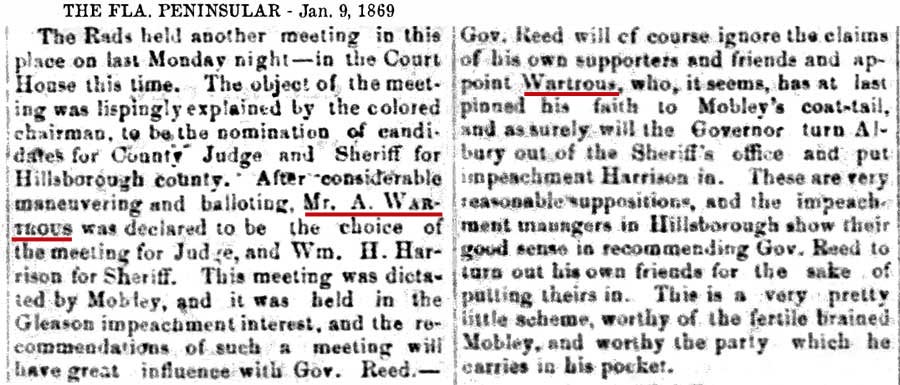 |
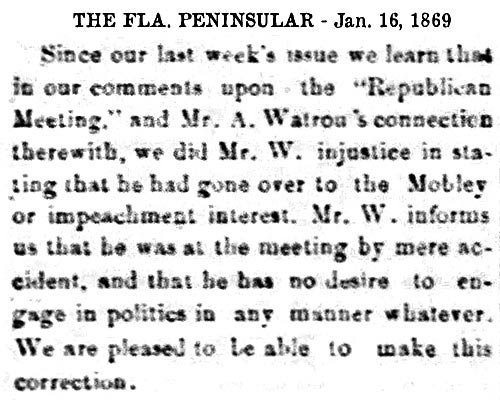 |
|
Notice: "The
object of the
meeting was lispingly
explained by the
colored chairman..."
The Peninsular was
in favor of Reed
being replaced with
Gleason and so took
issue with anything
that would oust
Gleason and put Reed
back in office,
though he had really
never been removed.
They saw the meeting
as an attempt to
install Ansel
Watrous as judge and
thus side with
Claiborne Mobley,
another deplorable
as far as the
Peninsular was
concerned.
Watrous wasn't even
a lawyer, the idea
of him being a judge
was beyond reason. |
|
ANSEL WATROUS ON COMMITTEE TO DRAFT
CONSTITUTION AND BYLAWS OF FIRST
HOOK & LADDER COMPANY
On Jun. 12, 1869,
citizens met at the courthouse to
discuss forming a hook & ladder
company (fire dept.) Franklin
Branch was the chairman of the
meeting and T.K. Spencer was chosen
as Secretary for the meeting.
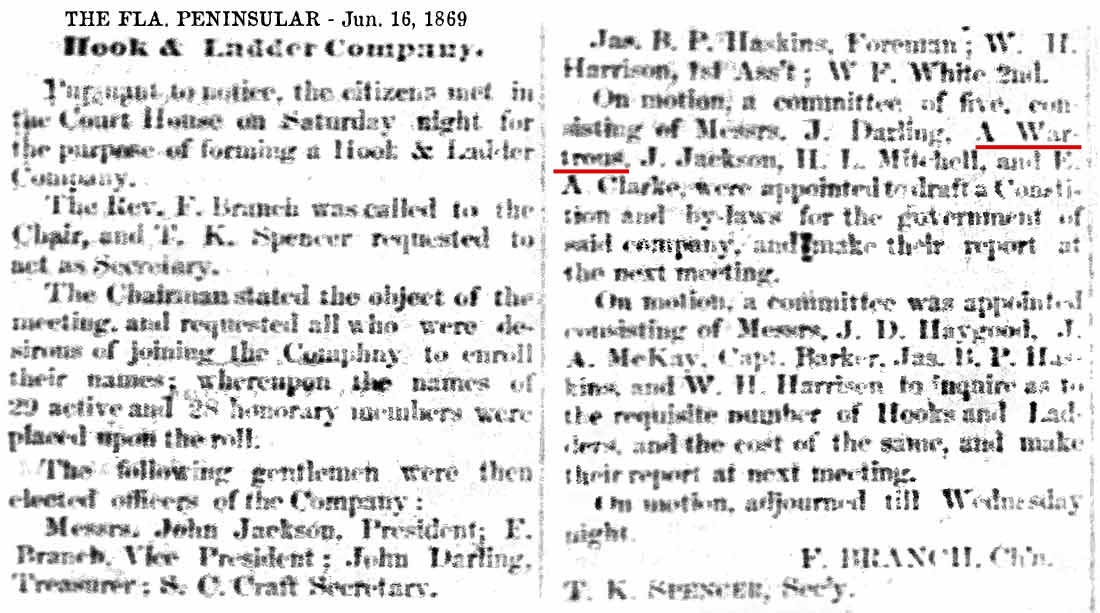
Those wishing
to join the company were asked to
submit their names. Twenty-nine
"active" members applied and "28
honorary members were placed on the
roll."
Officers were then
chosen: President - John
Jackson, VP - Franklin Branch,
Tresurer - John Darling, Secretary
-Sam C. Craft, Foreman - James B.P.
Haskins, 1st Asst. - W.H. Harrison,
2nd Asst. - W.F. White.
Then a committee
of five were chosen to draft a
constitution and bylaws and make a
report at the next meeting.: John
Darling, Ansel Watrous, John
Jackson, Henry L. Mitchell, and Ed
A. Clarke were chosen. A
committee was then chosen to
determine how many hooks & ladders
were needed, and the cost, to report
at the next meeting.
Nothing further is
found about this particular effort.
It's not until 1884 that a hook &
ladder company with actual
firefighters was formed--a
volunteer fire dept. with
A.C. Wuerpel as chief.
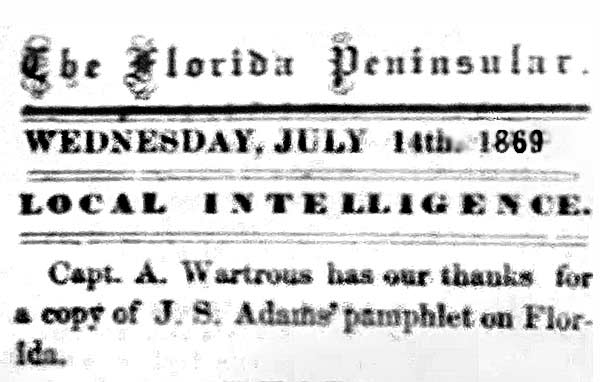
July 14, 1869 -
The Editor of the Peninsular thanked Capt.
A. Wartrous [sic]
for sending a copy of a pamphlet
about Florida. Perhaps it is
one that circulated in NY and
influenced his decision to come to
Tampa.
FOURTH OF JULY CELEBRATION PLANS
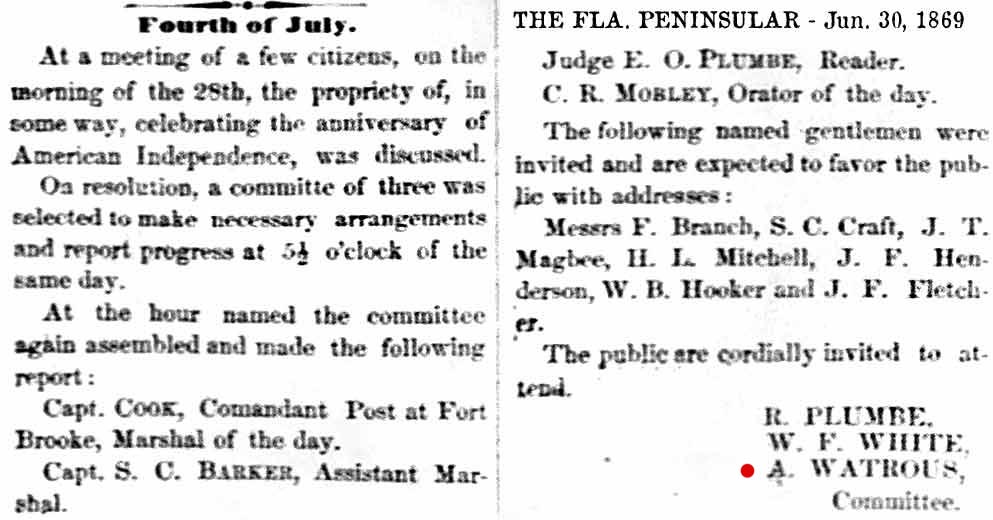
On Jun. 28, 1869,
Ansel Watrous was appointed
to a committee of three along with
R. Plumbe and William F. White to
make arrangements to have an
Independence Day ceremony in Tampa.
At 5:30 p.m. the
same day, they reported their plan:
Capt. Cook, the
Commandant at Fort Brooke was to be
the Marshal of the day.
Capt. S. C.
Barker, Asst. Marshal
Judge E. O. Plumbe,
Reader
Claiborne R.
Mobley, Orator of the day.
Other notables
were invited to make speeches:
Franklin Branch, Sam C. Craft, James
T. Magbee, Henry L. Mitchell, J. F.
Fletcher.
The celebration
was apparently postponed and
festivities carried out on the 5th.
On Jul. 7, the PENINSULAR REPORTED:
The
4th was an unusually hot day.
The thunder rolled almost
incessantly from daylight until
dark, but there was no rain during
the day. The 5th was duly
celebrated at Fort Brooke by
speaking and firing a National
salute in the morning, and the day
closed by a ball given at the
officer's quarters, and also one at
the Court House.
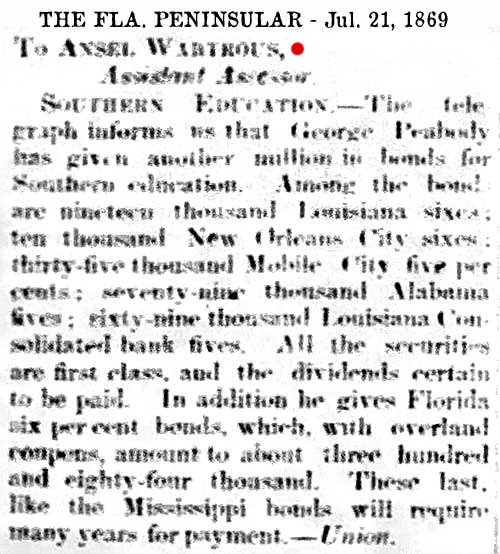
WATROUS
RECEIVES NOTICE OF PEABODY FUNDS FOR
FLORIDA EDUCATION
On
Jul. 21, 1869, the PENINSULAR
printed this message received by
telegraph, addressed to Ansel
Wartrous [sic], Asst. Assessor.
A million dollars in bonds had been
given to southern states for
educational purposes by the George
Peabody Fund. Florida was to
receive 6% bonds valued at about
$384,000 "like the Mississippi
bonds, will require many years for
payment."
It
is probable that by this time, Ansel
was a member of the newly created
Board of Instruction or Education.
A reference to him in this postion
has not yet been found in the
Peninsular.
|
Due to
the poor condition of
this article, it has
been reproduced to
resemble the format of
the original as closely
as possible. |
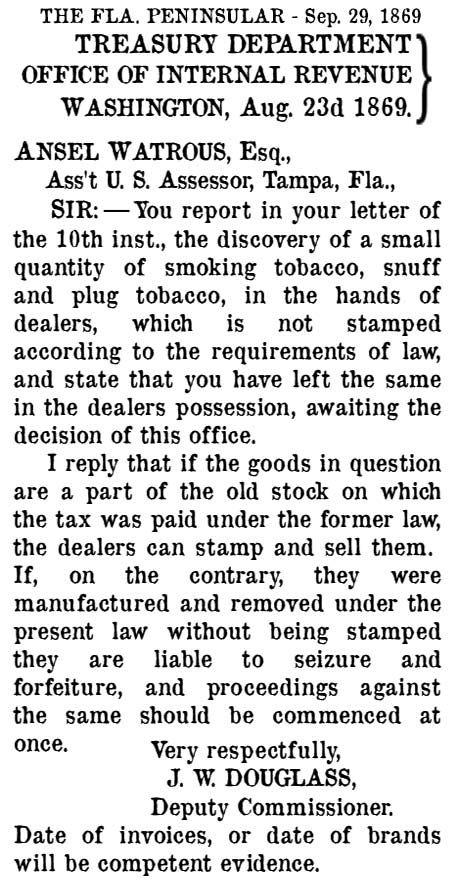 |
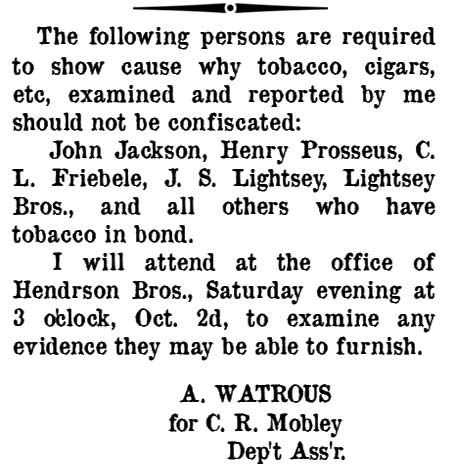 |
|
Watrous didn't score any
points with Tampans on
this one when he called
out the big dogs on the
influential and leading
merchants of the city
for what appeared to be
possession of untaxed
tobacco products.
What probably made
matters worse for
Watrous was that he was
working not only for the
Federal Government (and
a U.S. President,
Ulysses Grant, who led
the Union Army to defeat
the South) but as an
assistant to Claiborne
Mobley, a Republican.
Interesting to note here
is how the letter from
the Treasury Dept.
addresses Watrous as
"Esq." (Esquire) a term
usually meaning lawyer
or attorney. As
there is no evidence
that Watrous ever
obtained a degree in
law, this incidence is
likely an erroneous
assumption by Douglass,
or use of the term as a
courtesy title.
See "Esquire"
at Wikipedia |
Ansel Watrous
first appears in Tampa census records on the 1870 Census, living
in town along with other notables
and next to Henry Krause, yet Ansel
is listed as a farmer. There
is no reason known yet as to why he
appears to be listed as "Ansterop"
or "Austerop" or why Linda and
Hattie were listed as being born in
Mass. Maybe they weren't home
and a neighbor gave the info.
1870 Census, Tampa

-GAZETTE---Death-of-Melinda-Burnett-Watrous.jpg)
ANSEL
WATROUS, JR FAMILY BACK TO MISSOURI,
DEATH OF MELINDA WATROUS
It
appears that from Tampa, Ansel Jr.
and his family moved back to Oregon
City, Holt Co., Missouri by Nov.
1873. Perhaps so his wife
Melinda could be with her family a
while and the Burnetts could see
their Watrous grandchildren/cousins.
It is
there where Melinda died and is
buried in Maple Grove Cemetery.
Find A Grave,
memorial page for Melinda Burnett
Watrous (1 Sep 1841–23 Nov
1873), Memorial no. 99242081,
citing Maple Grove Cemetery, Oregon,
Holt County, Missouri, USA.
Maintained by Tami Glock
(contributor 46872676) .
Here
is seen Ansel's formal name:
Anselm.
According to Ernst Förstemann,
Altdeutsches Namenbuch (1900),
page 128, and many other sources,
the usage is of German & Ancient
Germanic origin, rarely of English.
It is pronounced AN-zelm (German) or
AN-selm (English)
Meaning & History: Derived from the
Germanic elements ans
"god" and helm
"helmet, protection." This name was
brought to England in the late 11th
century by Saint Anselm, who was
born in northern Italy. He was
archbishop of Canterbury and a
Doctor of the Church.
Related Names Variant - Ansehelm
(Ancient Germanic) / Feminine Forms
- Anselma, Elma (German) / Other
Languages & Cultures: Anselmi,
Anssi(Finnish) Anselme (French)
Anselmo (Italian) Anselmo
(Portuguese) Anselmo (Spanish)
Anshel (Yiddish)
ANSEL WATROUS, JR REMARRIES IN
ARLINGTON, VA
Ansel
Watrous married on Apr. 13, 1874 to
Louisa K. (Taylor) Crocker in
Arlington, VA.
Louisa
was the widow of Francis Platt
Crocker. They had married Sep.
17, 1860 in Philadelphia when Louisa
Taylor was 24, so she was born
around 1835-36 making her a few
years older than Ansel. Mr.
Crocker was 38 when he married
Louisa, and he died on Feb. 26, 1873
in Arlington, VA.
ANSEL AND LOUISE WATROUS - 1880
CENSUS IN CONNECTICUT
1880 Census, Middletown, Middlesex
Co., CT
Ansel Jr. and Louisa Watrous
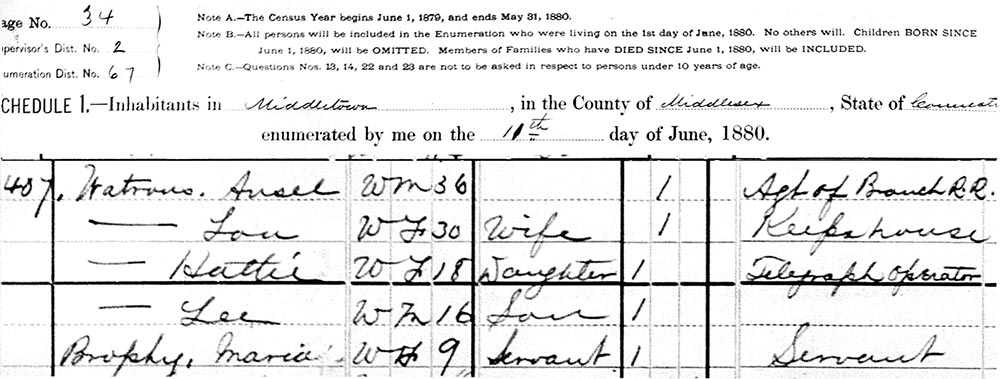
Here Ansel was
working as an agent of Branch
Railroad; daughter Hattie was a
telegraph operator.
Ansel and Lou's ages here are off,
he would have been 41, Lou would
have been around 44 to 45.
Their birth places have been cropped
out because the enumerator wrote "CONN"
for everybody, including everybody's
parents, which is completely
incorrect.
It is likely that the information
was given by Hattie, Lee, or even
the 9 year old servant.
According to New York City
municipal records, Ansel died in
Manhattan at age 47, Mar. 29, 1886.
He is buried at Arlington National
Cemetery where his tombstone also
shows the same date, along with his
birthday and Civil War rank.
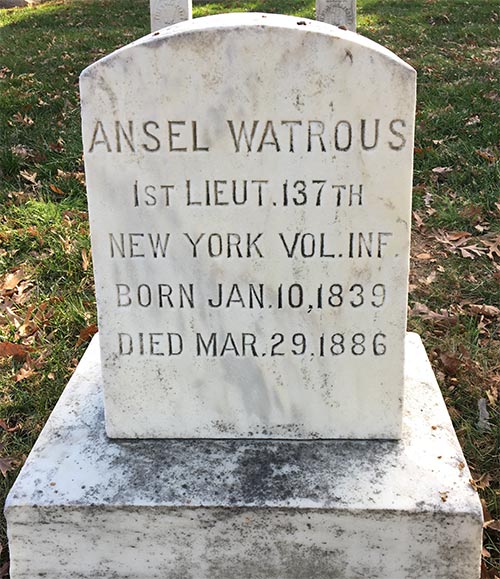
|



